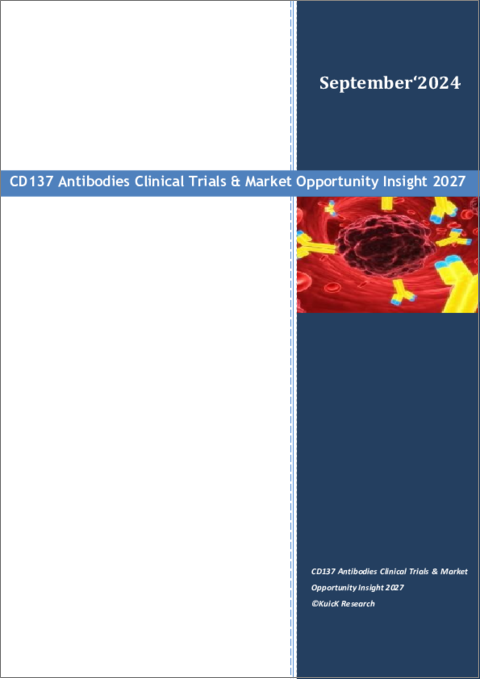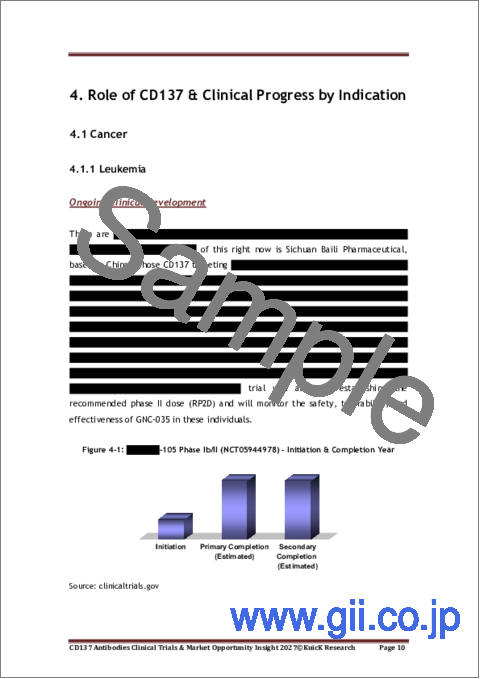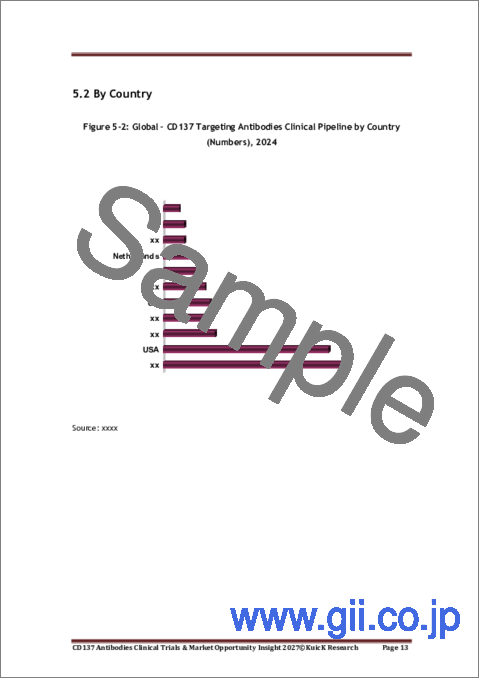|
|
市場調査レポート
商品コード
1551217
CD137抗体の臨床試験と市場機会に関する洞察:2027年CD137 Antibodies Clinical Trials & Market Opportunity Insight 2027 |
||||||
|
|||||||
| CD137抗体の臨床試験と市場機会に関する洞察:2027年 |
|
出版日: 2024年09月01日
発行: KuicK Research
ページ情報: 英文 210 Pages
納期: 即日から翌営業日
|
- 全表示
- 概要
- 図表
- 目次
4-1BBとしても知られるCD137は、近年がん免疫療法の有望なターゲットとして浮上しています。CD137を標的とした治療法の可能性は、細胞傷害性T細胞を刺激・増殖させ、腫瘍細胞の殺傷能力を向上させ、免疫記憶を長期間持続させる能力にあります。その結果、この分野は研究者からも製薬会社からも注目されるようになり、いくつかの研究論文がこのがん治療アプローチの有望な将来を示唆しています。さらに、初期の臨床試験から得られたデータはすでに治療効果を実証し始めており、CD137を標的とした薬剤開発のリアルタイムでの検証を提供しています。
現在市販されている認可された薬剤がないため、CD137標的治療薬はまだ初期段階にあります。それにもかかわらず、臨床開発のさまざまな段階にあるパイプラインには候補が豊富にあり、中でも第2相が最高です。BioNTech、Genmab、Adagene、Shanghai Henlius Biotechなどの大手製薬会社やバイオテクノロジー企業が、このターゲットの可能性を認識し、医薬品開発プログラムを積極的に進めています。このことは、免疫腫瘍学分野における既存企業にとっても新規参入企業にとっても大きな機会となっています。
CD137を標的とする治療法は、免疫チェックポイント阻害剤のような既存の免疫療法の欠点を克服することができます。チェックポイント阻害剤はがんの治療法を根本的に変えたが、これに反応する患者やがん種はごく一部に過ぎないです。CD137アゴニストによって、免疫療法の恩恵を受けられる患者の範囲が拡大し、現在利用可能なこれらの治療法の有効性が強化あるいは補完される可能性があります。
臨床開発中の最先端のCD137標的治療薬はアゴニスト抗体です。これらの化合物が意図する効果は、CD137シグナル伝達を活性化することによってT細胞の生存、増殖、エフェクター活性を刺激することです。抗腫瘍効果と安全性に関しては、初期の臨床試験で有望な結果が得られています。YH004、ADG106、ADG206、ATOR-1017は、現在臨床試験中のいくつかのCD137アゴニスト抗体です。とはいえ、特定の候補では用量制限的な肝毒性が見られるなど、課題もあります。このため、二重特異性抗体やテーラーメイドのリガンドなど、より優れた安全性と有効性をもたらす可能性のある他の戦略が研究されています。
結論として、CD137標的治療は、がんや免疫系が関与する他の様々な疾患の治療を変える大きな機会となります。CD137の生物学的性質の理解が深まりつつあり、抗体工学や併用戦略の発展とともに、この領域における新規性のための強固な基盤を提供しています。CD137を標的とする治療法は、医学界における大きなギャップを埋め、がん免疫療法市場の大きな部分を獲得する可能性を秘めており、開発と革新のための強力なケースを提示しています。
当レポートは、世界のCD137抗体市場について調査し、市場の概要とともに、薬剤動向、臨床試験動向、地域別動向、および市場に参入する企業の競合情勢などを提供しています。
目次
第1章 CD137の概要
第2章 世界のCD137抗体市場の見通し
- 現在の調査と市場の状況
- 将来の商業化の機会
第3章 CD137抗体の臨床開発、地域別
- 中国
- 米国
- 韓国
- 欧州
- オーストラリア
第4章 CD137の役割と適応症別の臨床進歩
- がん
- 自己免疫疾患および炎症性疾患
- 微生物感染症
第5章 世界のCD137抗体の臨床試験の概要
- 企業別
- 国別
- 適応症別
- 相別
- 患者セグメント別
第6章 CD137阻害剤の臨床試験に関する考察(企業、国、適応症、相別)
- 研究
- 前臨床
- 第I相
- 第I/II相
- 第II相
第7章 CD137の標的技術プラットフォーム、企業別
第8章 CD137の抗体分類別の治療法
- モノクローナル抗体に基づく戦略
- 二重特異性抗体を中心としたアプローチ
- 三重特異性抗体確立戦略
- 四特異性抗体戦略
第9章 CD137抗体を用いた併用療法
第10章 競合情勢
- ABL Bio
- Adagene
- Alligator Bioscience
- BeiGene
- Bicycle Therapeutics
- BioNTech
- Biotheus
- Crescendo Biologics
- Eutilex
- F-star Therapeutics
- Genmab
- I-MAB Biopharma
- Lyvgen Biopharma
- OriCell Therapeutics
- Pieris Pharmaceuticals
- Shanghai Henlius Biotech
- Sichuan Baili Pharmaceutical
- SystImmune
List of Figures
- Figure 1-1: Anti-CD137 Monoclonal Antibody - Immune Regulation Mechanisms
- Figure 1-2: Schematic Depiction Of Bidirectional Signaling By CD137-CD137L
- Figure 2-1: CD137 First Approval Sales Estimate - First 12 Months & First 24 Months (US$ Million)
- Figure 4-1: GNC-035-105 Phase Ib/II (NCT05944978) - Initiation & Completion Year
- Figure 4-2: GNC-035-101 Phase I (NCT05944978) - Initiation & Completion Year
- Figure 4-3: GNC-038-101 Phase I (NCT04606433) - Initiation & Completion Year
- Figure 4-4: ACIT001 Phase Ib/II (NCT03938987) - Initiation & Completion Year
- Figure 4-5: BP41072 Phase I/II (NCT04077723) - Initiation & Completion Year
- Figure 4-6: YH004 Phase I (NCT05564806) - Initiation & Completion Year
- Figure 4-7: EU-CTS101-I-01 Phase I/II (NCT04903873) - Initiation & Completion Year
- Figure 4-8: GCT1046-04 Phase 2 (NCT05117242) - Initiation & Completion Year
- Figure 4-9: GCT1046-04 Phase 2 (NCT05117242) - Initiation & Completion Year
- Figure 4-10: GCT1046-04 Phase II (NCT05117242) - Initiation & Completion Year
- Figure 4-11: Phase I/II (NCT03809624) - Initiation & Completion Year
- Figure 4-12: INBRX-105 Phase I (NCT03809624) - Initiation & Completion Year
- Figure 4-13: C-1100-01 Phase I (NCT04121676) - Initiation & Completion Year
- Figure 4-14: QLF31907-201 Phase 2 (NCT05823246) - Initiation & Completion Year
- Figure 4-15: AVIATOR Phase 2 (NCT03414658) - Initiation & Completion Year
- Figure 4-16: ADG106-T6002 Phase 1/2 (NCT05275777) - Initiation & Completion Year
- Figure 4-17: YH32367-101 Phase I/II (NCT05523947) - Initiation & Completion Year
- Figure 4-18: GNC-035-103 Phase 1 (NCT05160545) - Initiation & Completion Year
- Figure 4-19: BP42675 Phase Ib (NCT04826003) - Initiation & Completion Year
- Figure 4-20: EU-CTS101-I-01 Phase I/II (NCT04903873) - Initiation & Completion Year
- Figure 4-21: 2017-0180 Phase 1 (NCT03290937) - Initiation & Completion Year
- Figure 5-1: Global - CD137 Targeting Antibodies Clinical Pipeline by Company (Numbers), 2024
- Figure 5-2: Global - CD137 Targeting Antibodies Clinical Pipeline by Country (Numbers), 2024
- Figure 5-3: Global - CD137 Targeting Antibodies Clinical Pipeline by Indication (Numbers), 2024
- Figure 5-4: Global - CD137 Targeting Antibodies Clinical Pipeline by Phase (Numbers), 2024
- Figure 5-5: Global - CD137 Targeting Antibodies Clinical Pipeline by Patient Segment (Numbers), 2024
- Figure 7-1: Adagene - Anti CD137 NEObody ACG106
- Figure 7-2: Adagene - Anti CD137 POWERbody ADG206
- Figure 7-3: Genmab - DUObody Production Process
- Figure 7-4: Crescendo Biologics - Humabody Structure
- Figure 7-5: Crescendo Biologics - CB307 Structure
- Figure 7-6: Numab Therapeutics - MATCH Format
- Figure 7-7: Systimmune - GNC-039 Structure
- Figure 7-8: Systimmune - GNC-035 Structure
- Figure 7-9: Systimmune - GNC-038 Structure
- Figure 7-10: Merus - Multiclonics Structure
- Figure 7-11: Chugai Pharmabody Research - Dual-Ig(R) Technology
- Figure 7-12: Eutilex - Costim Platform Technology
- Figure 8-1: ATOR-1017 - Mechanism Of Action
- Figure 8-2: EU101 - Mode Of Action
- Figure 8-3: LVGN6051 - Mechanism Of Action
- Figure 8-4: ABL503 - Structure & Mechanism Of Action
- Figure 8-5: FS120 - Improving PD-1 & Chemotherapy Responses
- Figure 8-6: MP0310 - Mechanism Of Action
List of Tables
- Table 4-1: Lymphoma - Clinical Trials Underway for GNC-038 & GNC-035
- Table 8-1: Bispecific Antibodies Targeting CD137/4-1BB in Clinical Trials
- Table 8-2: Trispecific Antibodies Targeting CD137/4-1BB in Clinical Trials
- Table 8-3: Tetraspecific Antibodies Targeting CD137/4-1BB in Clinical Trials
- Table 9-1: Ongoing Clinical Trials Evaluating CD137 Antibody Combinations
CD137 Antibodies Clinical Trials & Market Opportunity Insight 2027 Report Highlights:
- Currently No Drug Commercially Available In Market
- More Than 80 Drugs In Clinical Trials
- Highest Clinical Trials Phase: Phase II (7 Drugs)
- CD137 Drugs Market Opportunity In Initial 24 Months Of Launch: > US$ 400 Million
- Global & Regional Trends (Clinical & Commercial)
- CD137 Inhibitors Clinical Trials Insight By Company, Country, Indication & Phase
- CD137 Therapeutic Approaches By Antibodies Classification
- Role Of CD137 & Clinical Progress By Indication
CD137, also known as 4-1BB, has emerged as a promising target for cancer immunotherapy in recent years. The potential of CD137-targeted therapies lies in their ability to stimulate and expand cytotoxic T cells leading to improved tumor cell killing and long-lasting immune memory. As a result, the field has gained attention from researchers and pharmaceutical companies alike, with several research publications hinting at a promising future for this cancer therapeutic approach. Moreover, data emerging from early clinical trials have already begun demonstrating therapeutic benefits, providing real-time validation of CD137-targeted drug development.
With no licensed medications currently on the market, CD137-targeted therapies are still in their infancy. Nonetheless, there is an abundance of candidates in the pipeline in different phases of clinical development, with phase 2 being the highest. Several major pharmaceutical companies and biotech firms, including BioNTech, Genmab, Adagene, and Shanghai Henlius Biotech, are actively pursuing drug development programs after recognizing the potential of this target. This presents a significant opportunity for both established players and newcomers in the field of immuno-oncology.
The ability of CD137-targeted treatments to get past some of the drawbacks of existing immunotherapies, like immune checkpoint inhibitors, is one of their main advantages. Although checkpoint inhibitors have fundamentally altered the way that cancer is treated, only a small percentage of patients and cancer types respond well to them. The range of individuals who can benefit from immunotherapy may be increased by CD137 agonists, which may enhance or supplement the effectiveness of these currently available treatments.
The most advanced CD137-targeted therapies in clinical development are agonistic antibodies. The intended effect of these compounds is to stimulate T cell survival, proliferation, and effector activities via activating CD137 signaling. Regarding anti-tumor effectiveness and safety characteristics, early clinical trials have produced encouraging results. YH004, ADG106, ADG206, and ATOR-1017 are a few CD137 agonistic antibodies that are now undergoing clinical trials. There have been challenges, nevertheless, such as dose-limiting hepatotoxicity seen in certain candidates. Due to this, other strategies are being investigated that might provide better safety and efficacy profiles, such as bispecific antibodies and tailored ligands.
Combining CD137-targeted therapies with other immunomodulatory drugs is one highly intriguing area of investigation. CD137 agonists have been shown to have synergistic benefits when paired with checkpoint inhibitors, chemotherapy, targeted therapy, or even radiation therapy, according to preclinical research and early phase clinical evidence. These combination approaches may result in more potent and more persistent anti-tumor responses, which would fulfill the unmet demand for efficient treatments for malignancies that are challenging to treat.
The market potential for effective CD137 antibodies is significant, considering the wide range of applications of CD137-targeted treatments in cancer. New and efficient treatment modalities are highly sought after, as the global market for cancer immunotherapy is expected to grow to many billions of dollars in the next several years. A sizeable portion of this market may be taken up by CD137-targeted treatments, especially if they show greater efficacy and can treat conditions where immunotherapies have not been very successful.
Furthermore, the versatility of CD137 as a target extends beyond oncology. Recent studies point to possible uses in transplantation, autoimmune diseases, inflammatory disorders, and infectious diseases. This wide-ranging therapeutic potential could open up additional market opportunities for drug developers, willing to explore these indications.
Despite the promising outlook, several challenges need to be addressed in the development of CD137-targeted therapies. These include optimizing dosing regimens to balance efficacy and safety, identifying predictive biomarkers for patient section, and developing strategies to overcome potential resistance mechanisms. Overcoming these hurdles will be crucial for the successful translation of CD137-targeted therapies from bench to bedside.
In conclusion, CD137-targeted therapies represent a significant opportunity to transform treatment of cancer and various other diseases involving the immune system. The increasing comprehension of CD137 biology, in conjunction with developments in antibody engineering and combination strategies, offers a robust basis for novelty in this domain. CD137-targeted therapies have the potential to fill a significant gap in the medical community and gain a significant portion of the cancer immunotherapies market, which presents a strong case for development and innovation.
Table of Contents
1. Brief Introduction To CD137
- 1.1 Clinical Overview
- 1.2 Biological History Of CD137
- 1.3 CD137 Hosting An Era Of Agonists Over Antagonists
- 1.4 Bi-Directional Signaling In CD137
2. Global CD137 Antibody Market Outlook
- 2.1 Current Research & Market Scenario
- 2.2 Future Commercialization Opportunities
3. CD137 Antibody Clinical Developments by Regions
- 3.1 China
- 3.2 US
- 3.3 South Korea
- 3.4 Europe
- 3.5 Australia
4. Role Of CD137 & Clinical Progress By Indication
- 4.1 Cancer
- 4.1.1 Leukemia
- 4.1.2 Lymphoma
- 4.1.3 Lung Cancer
- 4.1.4 Melanoma
- 4.1.5 Breast Cancer
- 4.1.6 Colorectal Cancer
- 4.2 Autoimmune & Inflammatory Diseases
- 4.3 Microbial Infections
- 4.3.1 Viral Infections
- 4.3.2 Bacterial infections
5. Global CD137 Antibodies Clinical Trials Overview
- 5.1 By Company
- 5.2 By Country
- 5.3 By Indication
- 5.4 By Phase
- 5.5 By Patient Segment
6. CD137 Inhibitors Clinical Trials Insight By Company, Country, Indication & Phase
- 6.1 Research
- 6.2 Preclinical
- 6.3 Phase I
- 6.4 Phase I/II
- 6.5 Phase II
7. CD137 Targeting Proprietary Technology Platforms By Companies
8. CD137 Therapeutic Approaches By Antibodies Classification
- 8.1 Monoclonal Antibody Based Strategies
- 8.2 Bispecific Antibody Centered Approaches
- 8.3 Trispecific Antibody Established Strategies
- 8.4 Tetraspecific Antibody Strategies
9. Combination Therapies With CD137 Antibodies
10. Competitive Landscape
- 10.1 ABL Bio
- 10.2 Adagene
- 10.3 Alligator Bioscience
- 10.4 BeiGene
- 10.5 Bicycle Therapeutics
- 10.6 BioNTech
- 10.7 Biotheus
- 10.8 Crescendo Biologics
- 10.9 Eutilex
- 10.10 F-star Therapeutics
- 10.11 Genmab
- 10.12 I-MAB Biopharma
- 10.13 Lyvgen Biopharma
- 10.14 OriCell Therapeutics
- 10.15 Pieris Pharmaceuticals
- 10.16 Shanghai Henlius Biotech
- 10.17 Sichuan Baili Pharmaceutical
- 10.18 SystImmune





